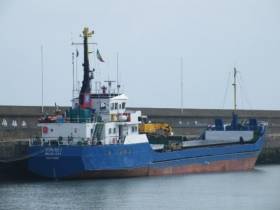Displaying items by tag: Brodick Ferry Redevelopment
Wicklow Regular Involved in Scottish Ferryport Redevelopment
#CargoTerminal - A Wicklow Port regular, cargoship Burhou I, has been involved in assisting construction of a new ferryport, away from routine ‘bread and butter’ cargoes such as round timber, writes Jehan Ashmore.
Among the various work related vessels at CalMac’s ferry terminal redevelopment at Brodick on the Isle of Arran, has involved the 647 tonnes general cargoship coaster, operated by Great Glen Shipping.
The veteran vessel dating from 1978, arrived loaded with primary rock armour for the project to be completed in summer 2017. The cargo was loaded at Furnace, Argyll across the Forth of Clyde.
Burhou 1 which normally discharges round timber (logs) cargoes from Scotland to Wicklow, had in March been detained by Port State Control for a single technical deficiency. After shifting berths to the East Pier, repairs were made to the 58m long, Belize City registered coaster. This was to satisfy PSC clearance prior to granting departure.
This evening, Burhou 1 is heading through the North Channel bound for Lochaline, Scotland, after a call to Passage West, Cork Harbour. This is a privately owned wharf, which regularly sees timber and scrap-metal cargoes as reported by Afloat back in 2011 that reflected on old Irish shipping firms.
Heading also northbound is another timber trader, Scot Ranger (1997/2,260gt) registered at Inverness, which too called to Wicklow. Shipowners, Scot Line, are regular clients of the east coast port where the 86m vessel arrived from Newport, south Wales to berth at Packet Quay.
Both vessels this evening are abreast of each other off the Co. Antrim coast.
One of eight in the fleet, Scot Ranger, is regularly engaged in supplying Swedish packaged timber products from Varberg to dedicated terminals in the UK and to Irish ports. Following the call to Wicklow, last night the 86m vessel anchored off Dublin Bay awaiting orders. She is now heading to Varberg.





























































